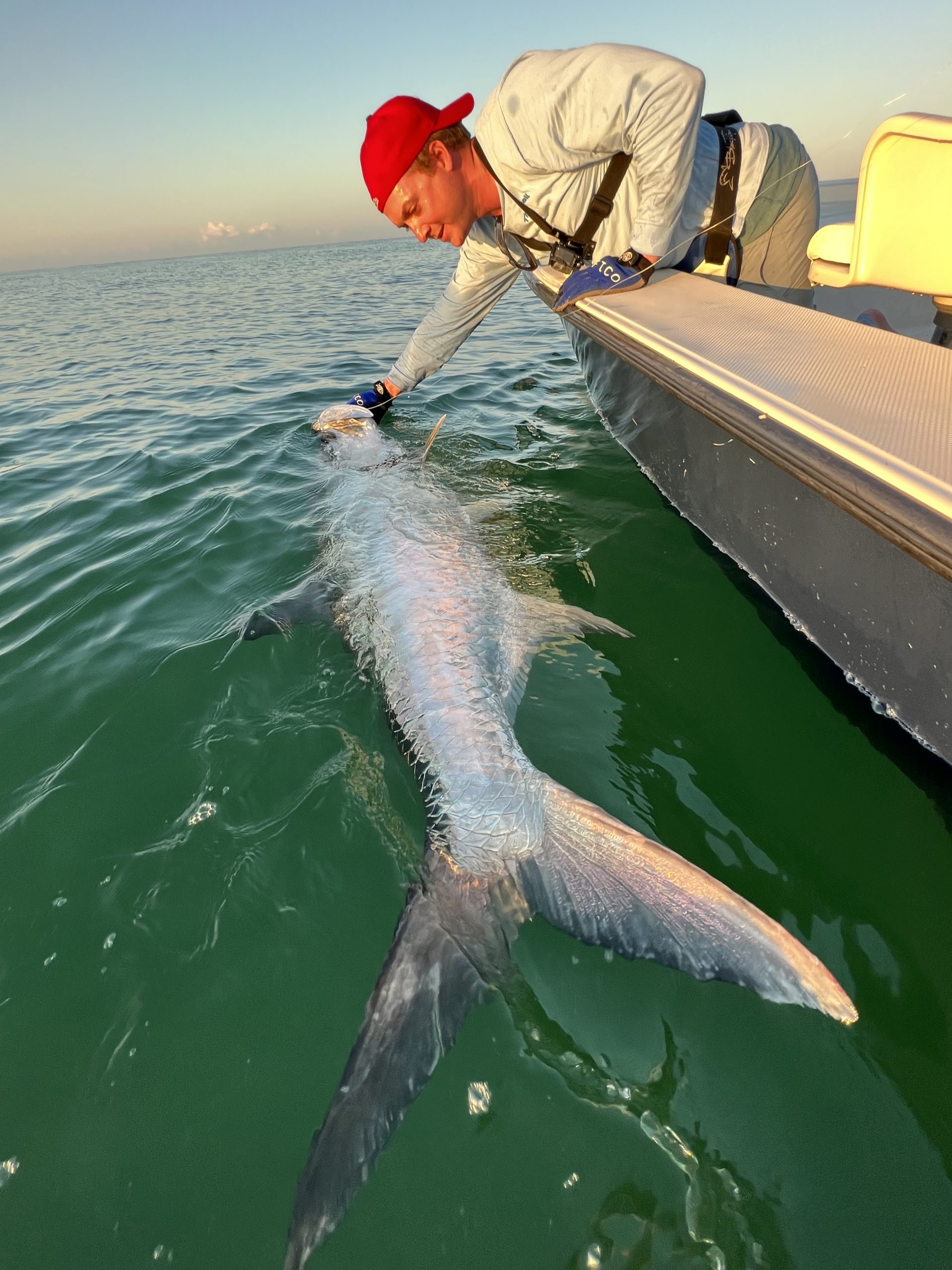Tarpon fishing is where it’s at right now. We’re in peak tarpon season and so far it’s not been disappointing.
There are fish off the beaches, some in the passes and a few in the backcountry. I’ve transitioned from a 6am departure to a 5:30am departing with the longer days. I love that golden hour from first light to sunrise. It’s a beautiful run down the beach with the light cracking over the horizon and sometimes we hook up within that hour.
Live crabs are the norm although pinfish, thread herrings and cut bait in the backcountry all work. We’ve had some epic battles with some big strong fish. Long time client and friend John Wittemore battled a huge big girthy girl for almost three hours, finally landed, revived and released. Tarpon had to be 150i plus. We had another almost two hour fight with Jeff Davis, another strong, wide healthy fish.
Check out my instagram account for cool videos of the latest action.
We have over a month left of peak tarpon season and I still have some days available in June. Scroll down for calendar with availability.
Give me a call or text.
Capt. Mark
239-450-9230
June Availability

Tarpon (Megalops Atlanticus) Biology
The Atlantic tarpon (Megalops atlanticus) is a ray-finned fish that inhabits coastal waters, estuaries, lagoons, and rivers. It is also known as the silver king. It is found in the Atlantic Ocean, typically in tropical and subtropical regions, though it has been reported as far north as Nova Scotia and the Atlantic coast of southern France, and as far south as Argentina. As with all elopiformes, it spawns at sea. Its diet includes small fish and crustaceans
The tarpon has a reputation for great aerobatics, attaining astonishing size, and having impressive armored scales. It is generally considered to be of poor food quality, but it is highly valued as a game fish by recreational fishermen.
Atlantic tarpon evolved approximately 18 million years ago and are one of the oldest living fish.
It has been recorded at up to 2.5 m (8 ft 2 in) in length and weighing up to 161 kg (355 lb). Males rarely weigh more than 100 pounds.
A tarpon is capable of filling its swim bladder with air, like a primitive lung. This gives it a predatory advantage when oxygen levels in the water are low. In appearance, it is greenish or bluish on top and silver on the sides. The large mouth is turned upwards and the lower jaw contains an elongated, bony plate. The last ray of the dorsal fin is much longer than the others, reaching nearly to the tail.
The Atlantic tarpon’s most significant predators are sharks and humans. The diet of the Atlantic tarpon changes as the fish grows with those in the leptocephalus stage absorbing nutrients directly from the water, those in the juvenile stage eating zooplankton and other small prey, and adults primarily consuming fish, crabs, and shrimp.
They inhabit both sides of the Atlantic Ocean. Their range in the eastern Atlantic has been reliably established from Senegal to the Congo. Tarpons inhabiting the western Atlantic are principally found to populate warmer coastal waters primarily in the Gulf of Mexico, Florida, and the West Indies. Nonetheless, they are regularly caught by anglers at Cape Hatteras and as far as Nova Scotia, Bermuda, and south to Argentina. In the Gulf of Mexico there are two distinct populations divided by the Mississippi River Delta.
Atlantic tarpon are highly migratory and often cross international boundaries. This introduces challenges in management and conservation.
Scientific studies indicate schools have routinely migrated through the Panama Canal from the Atlantic to the Pacific and back for over 80 years. Since tarpons tolerate a wide range of salinity and are opportunistic feeders, their migrations are limited only by water temperatures. They prefer water temperatures of 22 to 28 °C (72 to 82 °F); below 16 °C (61 °F) they become inactive, and temperatures under 4 °C (39 °F) can be lethal.[citation needed] A large tarpon community is found in the Rio San Juan and Lake Nicaragua.[19] In the Pacific a population has become established in Costa Rica.
Atlantic tarpon breed in spawning aggregations in the open ocean. Atlantic tarpon share a unique larval stage known as a leptocephalus with bonefish, ladyfish, and eels. Unlike the larvae of other fish these larvae do not eat as their long slender bodies have very low energy requirements. While larvae the Atlantic tarpon’s teeth grow pointed forward to keep debris out of their mouth. The leptocephali develop into juveniles which make their way inshore, often into stagnant water with a very low oxygen content which can’t be tolerated by most of their predators. When they are about three years old Atlantic tarpon migrate from these backwater habitats to a variety of nearshore ones, growing rapidly but primarily in length as opposed to girth. At around eight years of age an Atlantic tarpon reaches its sexual maturity and begins to gain length as well as girth. Growth rates also diverge at this point with males growing much slower than females. Sexually mature Atlantic tarpon will begin migrating to join spawning aggregations.
The post Naples & Marco Island Fishing Report first appeared on Naples Fishing Charters with Capt. Mark Ward.
Source link


